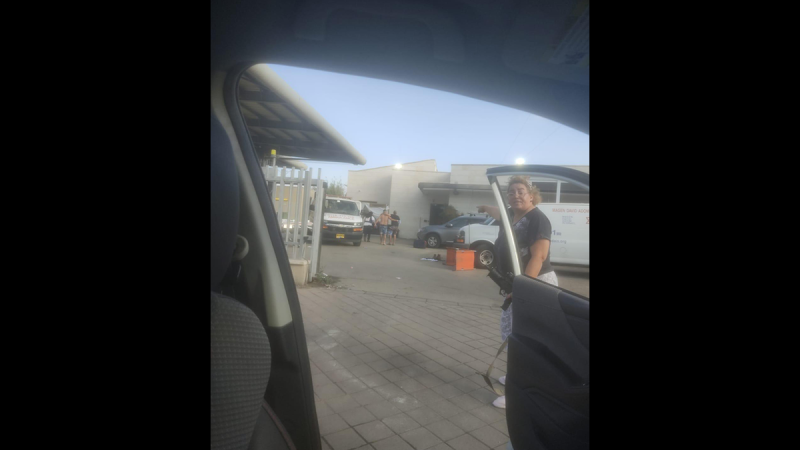
Saving lives on ‘Death Street,’ how an Israeli kindergarten teacher became a battlefield hero on October 7
Tali Hadad is a 49-year-old mother of six and a kindergarten teacher whose days would normally be spent teaching basic reading, math and social skills to 5-year-olds. She never imagined that one day she would be forced to make life-or-death decisions while under fire in the middle of a war zone.
But on Oct. 7, 2023, she was thrust into unimaginable circumstances.
As Hamas launched its assault at 6:45 a.m., she awoke to the sound of sirens and gunfire in her hometown of Ofakim, a small, working-class city in southern Israel 15 miles from the border with Gaza. The piercing alarms that filled the air signaled this was not an ordinary rocket attack, to which much of the region had, over the course of many years, become accustomed.
Hadad instantly knew her family was in grave danger.
Her son, Itamar, a soldier in officer training, was home on leave for the weekend. As the sounds of gunfire grew closer, he grabbed his rifle, fully aware that there was fighting just outside their door. Without hesitation, he ran toward the terrorists. Hadad, still in her pajamas, quickly slipped on running shoes and chased after him, her instincts as a mother taking over.
‘I ran toward the playground,’ Hadad told Fox News Digital. ‘I hid behind a wall and saw a line of terrorists walking with rifles, heading in the direction where my son had gone.’ Moments later, she heard gunshots. ‘I knew Itamar was in the middle of it. I waited, hoping he would come out, but he didn’t. So, I ran toward him.’
Dodging through alleys while gunfire rang out around her, Hadad saw the devastation unfold. ‘People were yelling from windows, begging for help,’ she said. ‘But there were no ambulances coming, no one to save them.’
Then, she saw Itamar. He had been shot multiple times – in the stomach, leg and thigh. Two of his comrades lay dead on the ground beside him.
‘He looked at me and said, ‘Mom, what are you doing here?’ I told him, ‘You’re hurt, I’m going to take you to the hospital,’’ she recalled.
With gunfire still echoing around her, Hadad sprinted back to her house, jumped into the family car and drove straight back to her son. ‘They put Itamar in the car, along with more of the wounded, and I drove as fast as I could, 120 kilometers per hour, to the Magen David Adom station (Israel’s national emergency medical service) at the entrance to the city,’ she said. ‘I knew if I drove slowly, the terrorists would shoot me.’
After handing Itamar over to the paramedics, she made a fateful decision. ‘I told him, ‘Mom isn’t coming with you. You’ll go in the ambulance, I’ll join you later. I have to go back and help the others.’’
Hadad returned to the scene of the fighting and made three more trips to rescue 13 people in total, all while under constant fire. ‘People tried to stop me,’ she said. ‘They told me it was too dangerous, but I took Itamar’s rifle, and I knew this was something I had to do. I had no choice but to act.’
After hours of intense fighting involving police officers, forces from the Yamam special-operations unit, armed civilians and off-duty soldiers, Israeli forces regained control of the town. A helicopter arrived to evacuate the wounded. Only then was Hadad able to step away from her role as a rescuer and check on her son at the hospital. Itamar had survived, but his road to recovery would be long.
‘Half of the rehabilitation is physical, and half is mental,’ Itamar Hadad told Fox News Digital, reflecting on the traumatic events of that day, the friends he lost in the battle, and those he has lost since in Gaza, where his unit, Sayeret Nahal, has suffered many casualties. Despite the pain, his dream remains to return to his unit and continue fighting in the ongoing multi-front war.
On Oct. 7, 47 of Ofakim’s 50,000 residents were murdered, and the street where Hadad lives became known as Rechov Ha’Mavet – ‘Death Street.’
A year after the attack, Ofakim is rebuilding. Death Street, once a symbol of horror, has been renovated. The city has built a memorial, painted murals and planted olive trees – a sign of life replacing the destruction.
‘We’ve gathered the pieces, all the memories of the victims, and we’re trying to bring life back to the place that was destroyed,’ Hadad said.
Ofakim was not among the many towns and settlements in the south that were resettled in other parts of Israel. But the psychological scars remain. The waiting list for trauma counseling has grown, overwhelming the available therapists. In response, the Israel Psychoanalytic Society and the NGO IsraAid established a multidisciplinary trauma center, offering free mental health support to survivors of the massacre.
Hadad, like many others in Ofakim, and in the entire country, continues to struggle with the emotional aftermath. ‘We’re still bleeding,’ she said. For her, the experience was life-changing. She hasn’t returned to work since the attack, choosing, instead, to stay home and care for Itamar. Five of her six children are serving in the IDF, either on active duty or in the reserves. At the moment, two of them are fighting in Gaza. Her youngest daughter will enter the army in a month.
The community of Ofakim continues to heal, but the memories of Oct. 7 will never fade. ‘We remember how our children ran through the streets barefoot, fighting like lions. No politicians come here anymore. No tour buses arrive. But we remember. We will always remember,’ Hadad said.
